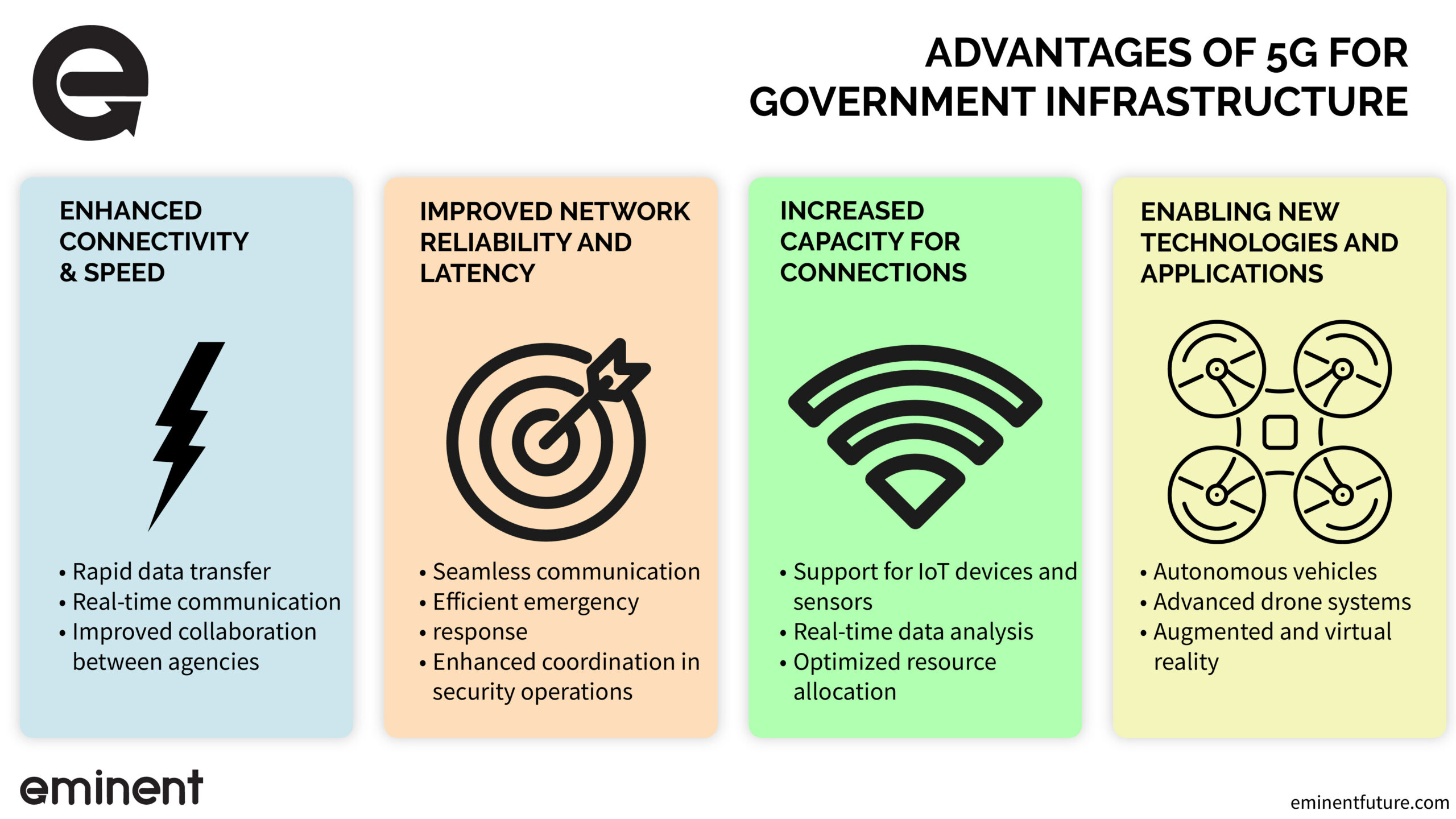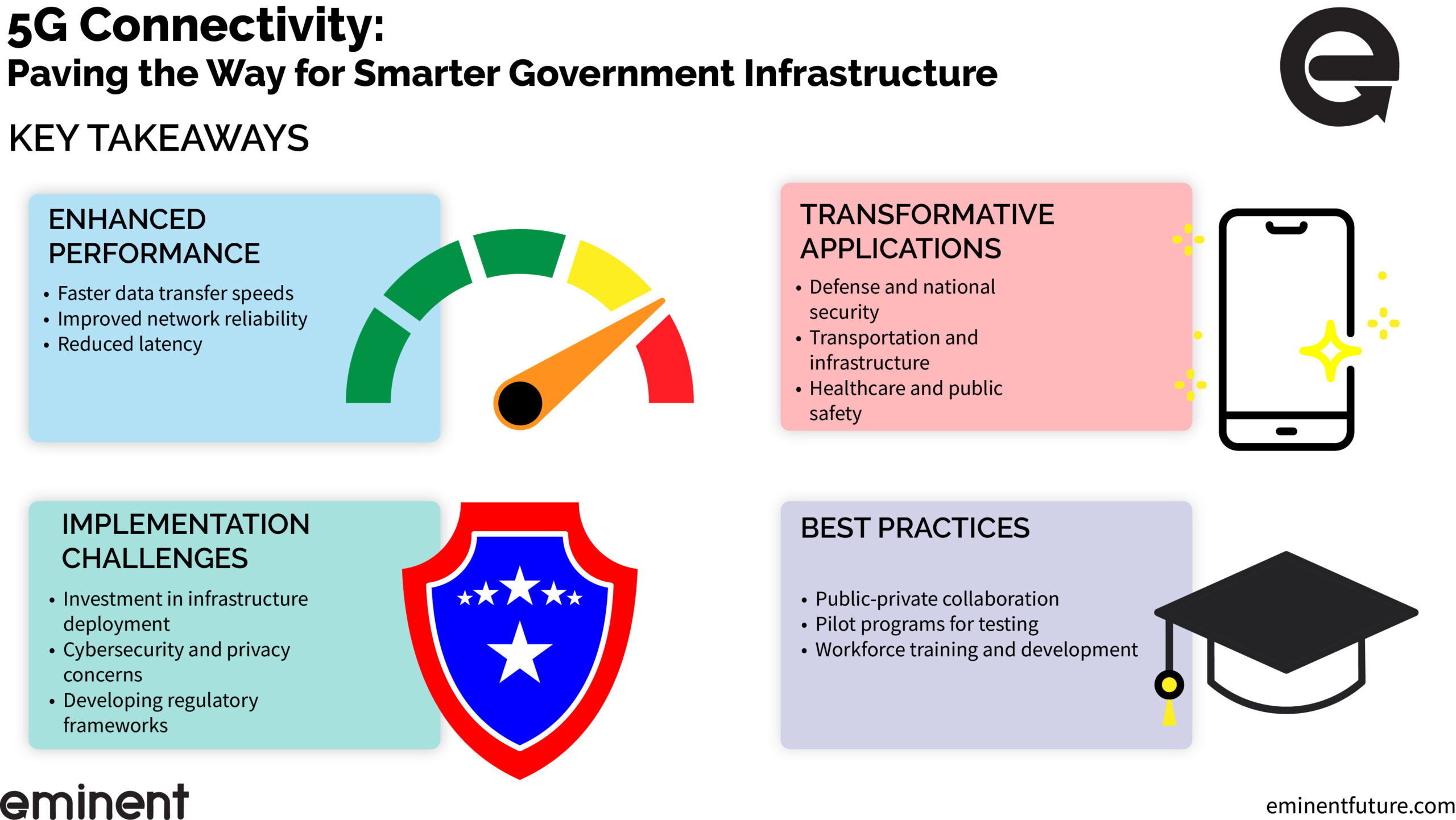
In today’s increasingly connected world, governments face mounting pressures to modernize their infrastructure and services to meet the rapidly evolving needs of their constituents. The fifth generation of mobile networks, 5G, promises to be a game-changer. Offering unprecedented speeds, reliability, and capacity, 5G has the potential to revolutionize the way federal agencies operate and deliver services to the public.
This article will delve into the transformative power of 5G technology and its potential applications across crucial government sectors, including defense, transportation, emergency response, and healthcare. We will also examine the challenges and considerations involved in implementing 5G networks and best practices for 5G adoption in federal agencies.
As we embark on this journey to understand the impact of 5G on modernizing government infrastructure, it is crucial to recognize the many benefits of groundbreaking technology. From enhanced connectivity to enabling new technologies, 5G paves the way for federal agencies to embrace a future marked by increased efficiency, improved services, and better outcomes for the communities they serve.
By exploring the vast possibilities of 5G technology, federal agencies can chart a path toward a connected future that strengthens national security, promotes public safety, and elevates the quality of life for all citizens. Embracing the 5G revolution will ensure that governments remain at the forefront of technological advancements and play a vital role in shaping a better, more connected world for generations to come.
The Advantages of 5G for Government Infrastructure

Enhanced connectivity and data transfer speeds
5G technology offers significant improvements in connectivity and data transfer speeds compared to previous generations of mobile networks. With the potential to achieve download speeds up to 100 times faster than 4G, 5G allows for the rapid exchange of large amounts of data, ultimately enhancing the efficiency of government operations. Increasingly rapid data transfer speeds can enable real-time communication and data sharing, improving collaboration between agencies and facilitating more timely decision-making.
Improved network reliability and latency
In addition to faster speeds, 5G allows networks to operate with greater reliability and significantly reduced latency, or the time it takes for data to be transmitted between devices. Lower latency enables smoother and more seamless communication, particularly in time-sensitive situations where rapid responses are crucial. This can translate to improved public safety, more efficient emergency response, and enhanced coordination in defense and national security operations for federal agencies.
Increased capacity for simultaneous connections
One of the key features of 5G technology is its ability to support a higher number of simultaneous connections, accommodating the growing number of connected devices and sensors within the Internet of Things (IoT). This increased capacity enables federal agencies to manage and analyze data from multiple sources in real time, providing a more comprehensive and accurate view of their operations. As a result, agencies can make more informed decisions and optimize resource allocation.
Enabling new technologies and applications
5G technology lays the foundation for developing and implementing new technologies and applications that were previously not possible or feasible. These advancements include deploying autonomous vehicles, advanced drone systems, and augmented or virtual reality for training and simulation purposes. By leveraging these cutting-edge technologies, federal agencies can enhance their operations, improve safety, and better address the challenges of the 21st century.
5G Applications in Key Government Sectors

Defense and National Security
Secure and rapid communication: 5G technology enables secure, high-speed communication channels for defense and national security agencies. This allows for real-time data exchange and seamless coordination during mission-critical operations.
Enhanced surveillance and reconnaissance: The improved connectivity and lower latency of 5G networks can facilitate advanced surveillance systems and reconnaissance operations, including drone-enabled aerial monitoring and data collection from multiple sources.
Transportation and Infrastructure
Smart traffic management systems: 5G can support the development of intelligent traffic management solutions that optimize traffic flow, reduce congestion, and improve overall transportation efficiency through real-time data analysis and communication between connected vehicles and infrastructure.
Connected and autonomous vehicles: The high-speed, low-latency capabilities of 5G networks enable the deployment of connected and autonomous vehicles, which can enhance safety, reduce traffic incidents, and revolutionize the transportation sector.
Emergency Response and Public Safety
Real-time communication and coordination: In emergencies, the reliability and speed of 5G networks can provide first responders with real-time communication and coordination capabilities, enabling more efficient and effective response efforts.
Advanced remote monitoring capabilities: 5G technology can support advanced remote monitoring systems, such as drone-based surveillance and IoT sensor networks, that provide real-time information to public safety officials, enhancing situational awareness and decision-making.
Healthcare
Telemedicine and remote diagnostics: The widespread adoption of 5G can enable high-quality telemedicine services and remote diagnostics, allowing healthcare providers to deliver care to patients in rural or underserved areas and expanding access to critical medical services.
Connected health devices and wearables: 5G networks can support the growing ecosystem of connected health devices and wearables, facilitating real-time health monitoring, data sharing, and personalized patient care, ultimately improving overall healthcare outcomes.
5G Applications in Key Government Sectors

Infrastructure Investment and Deployment
One of the primary challenges in implementing 5G technology is the significant investment required for infrastructure deployment. This includes the installation of new antennas, base stations, and other equipment to ensure robust and widespread network coverage. Governments must prioritize and allocate resources to facilitate the development of the necessary infrastructure while considering potential impacts on the environment and urban planning.
Cybersecurity Concerns and Protection
As 5G networks become increasingly common, cybersecurity concerns arise due to the potential for increased attack surfaces and the vulnerability of critical infrastructure. Governments must take proactive measures to secure 5G networks and develop strategies to protect against potential threats, such as investing in advanced cybersecurity technologies, fostering collaboration between public and private sectors, and developing security best practices.
Balancing National Security with Privacy Rights
Implementing 5G technology raises concerns regarding privacy rights and data protection. Increased connectivity and data sharing can potentially expose sensitive information. Governments must strike a balance between leveraging 5G for national security purposes and ensuring citizens’ privacy rights. Such considerations require establishing clear guidelines, promoting transparency, and developing appropriate legal data collection and usage frameworks.
Regulatory Frameworks and Policy Development
To ensure the successful implementation of 5G technology, governments must establish comprehensive regulatory frameworks and develop policies that guide its deployment and usage. This involves coordinating with international bodies, addressing spectrum allocation and licensing, and creating technology standards and interoperability guidelines. By fostering a supportive regulatory environment, governments can encourage innovation and the responsible adoption of 5G technology.
Best Practices for 5G Adoption in Federal Agencies

Collaborative approach between public and private sectors
To ensure successful 5G adoption, federal agencies should embrace a collaborative approach that fosters partnerships between the public and private sectors. By working together, government entities can leverage private companies’ expertise, resources, and innovation to accelerate 5G deployment and harness its full potential.
Pilot Programs to Test and Validate 5G Applications
Before fully implementing 5G technology, federal agencies should consider launching pilot programs to test and validate various 5G applications in controlled environments. These pilot programs can help identify potential challenges, assess the effectiveness of proposed solutions, and provide valuable insights to guide further development and refinement.
Workforce training and development
To maximize the benefits of 5G technology, federal agencies should invest in workforce training and development initiatives that empower employees with the necessary skills and knowledge. By providing staff access to training programs, workshops, and educational resources, agencies can ensure their workforce is well-equipped to adapt to and effectively utilize 5G technology.
Leveraging partnerships with industry leaders and experts
Federal agencies should seek partnerships with industry leaders and experts in the field of 5G technology to gain insights, share best practices, and access cutting-edge solutions. By tapping into the knowledge and expertise of these partners, agencies can learn from real-world experiences, stay up-to-date on the latest technological advancements, and accelerate the adoption of 5G technology.
5G Horizons: Charting the Path to a Connected Future
The potential of 5G technology to revolutionize government infrastructure and operations is clear, offering significant improvements in connectivity, network reliability, and capacity. As federal agencies leverage 5G to enable new technologies and applications, they can enhance their services and better address the needs of their constituents. However, successfully adopting 5G requires overcoming challenges and considerations, such as infrastructure investment, cybersecurity, privacy concerns, and regulatory frameworks.
Federal agencies must adopt a collaborative approach, engage in pilot programs, invest in workforce training, and forge strategic partnerships to harness the power of 5G fully. By overcoming challenges and embracing the transformative potential of 5G, governments can unlock a new era of infrastructure and services, ultimately redefining what it means to be a modern, innovative, and efficient government in the 21st century.
Key Takeaways




